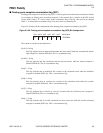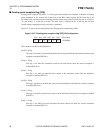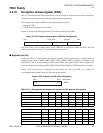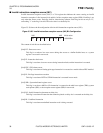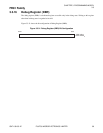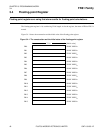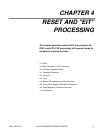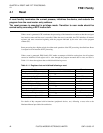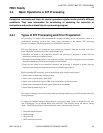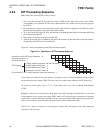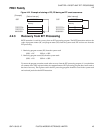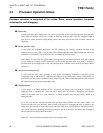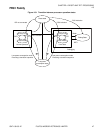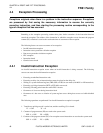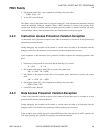
CM71-00105-1E FUJITSU MICROELECTRONICS LIMITED 43
FR81 Family
CHAPTER 4 RESET AND "EIT" PROCESSING
4.2
4.2 Basic Operations in EIT Processing
Exceptions, interrupts and traps are similar operations applied under partially different
conditions. They save information for terminating or restarting the execution of
instructions and perform branching to a processing program.
4.2.1 Types of EIT Processing and Prior Preparation
EIT processing is a method which terminates the currently executing process and transfers control to a
predetermined processing program after saving restart information to the memory. EIT processing
programs can return to the prior program by use of the RETI instruction.
EIT processing operates in essentially the same manner for exceptions, interrupts and traps, with a few
minor differences listed below by which it differentiates them.
• Exceptions are related to the instruction sequence, and processing is designed to resume from the
instruction in which the exception occurred.
• Interrupts originate independently of the instruction sequence. Processing is designed to resume from the
instruction immediately following the acceptance of the interrupt.
• Traps are also related to the instruction sequence, and processing is designed to resume from the
instruction immediately following the instruction in which the trap occurred.
While performing EIT processing, apply to the following prior settings in the program.
• Set the values in vector table (defining as data)
• Set the value of system stack pointer (SSP)
• Set the value of table base register (TBR) as the initial address in the vector table
• Set the value of interrupt level mask register (ILM) above 16(10000
B
)
• Set the interrupt enable flag (I) to "1"
The setting of interrupt level mask register (ILM) and interrupt enable flag (I), will be required at the time
of using interrupts.
To support the emulator debugger debug function, a processing called "break" is carried out in the user
state of debugging. The processing differs from usual EIT. The following shows the sources causing
"break". The break processing is executed when the source is detected in the user state.
• Instruction break exception
• Break interrupt
• Step trace trap
• INTE instruction execution



